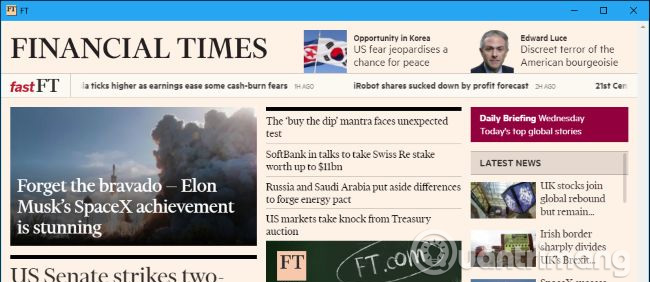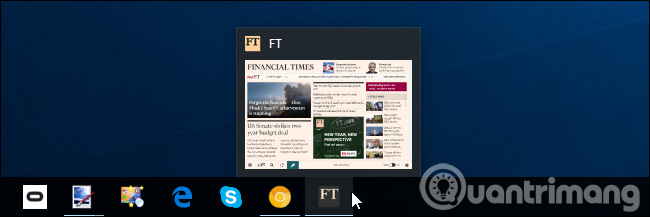What is Progressive Web App or PWA?
Have you ever wished for web applications to function like real applications? Progressive Web App is a new technology, developed aimed at doing that.
What is Progressive Web App or PWA?
Progressive Web App or PWA is a progressive web application that brings user experience with web access and features:
- Reliable: Load immediately and never show Internet disconnection (downasaur), even in flickering network conditions.
- Quick: Quickly respond to user interactions, smooth effects and no jumps.
- More attractive: The PWA application works exactly like the original application on the device, but with a better user experience, thus attracting more users.
Google, Microsoft, Mozilla and other companies are working on a new modern web application standard. Even Apple is pursuing and implementing support for it. These applications are web applications, but they work just like native applications. Just like existing web applications, they will be stored directly on the linked website. Developers can update the application directly on their web server without sending these updates to some application stores and the same application will run on all browsers, platforms.
When installing a Progressive Web App application, you will have a main screen, toolbar or screen shortcut to launch the application (depending on the user's platform). The application will load faster and have some offline support features, push notifications, support background sync and other modern gadgets.
These applications can also use existing web technologies to access location services, webcams and other features, often associated with native applications. Of course, it needs to send user requests to grant access before use.
How Progressive Web App works?

Progressive Web App is the traditional web application and is upgraded with modern web technology, providing an application-like experience. "Progressive" means they are "incrementally upgraded" with modern web features, which not only work on older browsers that do not support but also work well with many features in modern browsers.
These applications will have their own windows and taskbar shortcuts (on Windows 10 and Chrome-based operating systems) or icons on the main screen (on Android devices and other smartphones). When you open the application, you will see that they are loaded quickly using Cache API and IndexedDB, storing application resources and data on the device, allowing the application to work even when offline. Technologies such as Service Workers and push notifications will allow the application to perform background tasks such as synchronization and sending notifications to users even when not running, just like a real application. The Fetch API makes the application run faster and the data request process is simpler. The Manifest File Web App provides the name, logo, author and description used when installing the application to the main screen or desktop. They always use encrypted HTTPS to ensure safety and data cannot be tampered with when forwarding.
- What is HTTPS? and why is it needed for your site
Progressive Web App is unlike Google's Chrome Packaged App or Microsoft's Hosted Web App. These applications require to be "packaged" as a file and sent to an application store. The entire application is 'live' in a small offline package and users have to install it from the Chrome Web Store or Windows Store. This is also a specific platform and works only on Chrome or Windows. The developer must change the file of the offline application and send the new version to the app store to update it.
Instead, the PWA should never be packaged into an offline file. Like traditional web applications we use today, they are stored entirely on application servers. If the developer wants to update the Progressive Web App, they will perform the update exactly like updating the web application on the server. All platforms and browsers that support PWA can use the same Progressive Web App application.
PWA can be included in the application store so that users can easily find and install, but then the app store will point to the web application server. Even if the application is not compatible with the app store's content policy, users can find and install the application directly from the browser.

This technology not only makes applications work better but also sets new standards for applications that can be installed on any supported platform.
For example, Google may allow services such as Gmail and Google Calendar to act as PWA apps, which means they will run as main applications on Windows 10 and be included in the Windows Store. This helps users solve Windows Store application issues because Google does not support Microsoft Windows Platform (UWP). Other developers do not want to create standalone UWP applications, which can support Windows 10 with PWA.
- How to check the unified Windows application version (UWP) in Windows 10
Thanks to Progressive Web App, developers will have an easier way to make web applications more robust, integrated across multiple devices without having to go through any application store. Web applications work anywhere that is more competitive than applications that operate only on a single platform. Now companies can create PWA apps and support everything instead of creating apps exclusively for iOS, Android, Windows and the web.
Because developers provide Manifest Web App files, search engines will collect web data and make finding PWA easier like websites.
Which platforms are supported?

Progressive Web App has been developed for a while, but they are approaching a bigger leap in the public eye.
With the next update of Windows 10 codenamed Redstone 4, will be released in March 2018, Microsoft plans to support the PWA. As with other platforms, you can go to the PWA website and install it via Microsoft Edge. However, Microsoft will also bring Progressive Web App applications into the Store for easy installation. Developers can also put their applications into the Store, but Microsoft will also use Bing to find PWAs on the web and automatically list them. These applications are still stored and updated on their websites, but Microsoft makes it easier to find and install them. You will never need to open the Edge browser to search, install and run PWA on Windows 10.
On Google Chrome used on Windows, Mac, Linux or Chrome OS operating systems, the PWA application will replace the stopped "Chrome App" platform. Google said support for installing PWA desktops will be released in mid-2018. Then the PWA apps will work with Chrome on the desktop. This feature has been tested in the unstable development version of Chrome, named Canary.
On Android, Google Chrome as well as other mobile browsers such as Mozilla Firefox, Opera and Samsung browser have been supported to install PWA. Google is researching WebAPK technology that enables PWA files to be converted into APK files (Android application files) and installed on the device like other Android applications. Chrome's project manager said the PWA could be added to Play Store in the future.
Although Apple is not a proponent or participant in this trend, they are also adding PWA features to the Safari browser. 2018 will be an important year for PWA, especially on Windows 10, which can help Microsoft narrow the application gap and release more rich applications.
See more:
- Learn about Web applications
- Malicious Web Applications: How to detect and block them
- 10 golden principles to help create a successful web application
You should read it
- The wizard chooses the development platform for the application - Application Development Platform
- Elon Musk is nominated for the 2024 Nobel Peace Prize
- Google removed Chrome Apps from Chrome Web Store, prepared to say goodbye
- 5 free application building platforms do not need code
- File manager application Files is about to have a new version to support Windows 11
- Solution to increase enterprise application performance and secure remote access
 Why do you need to learn about IEEE 802.11ax?
Why do you need to learn about IEEE 802.11ax? Sleep or shutdown: Which option is better for your PC?
Sleep or shutdown: Which option is better for your PC? Instructions for checking the available RAM capacity of your device
Instructions for checking the available RAM capacity of your device Instructions on how to compile and execute Java using Command Prompt
Instructions on how to compile and execute Java using Command Prompt Guide the most simple and effective way to write easy-to-read code
Guide the most simple and effective way to write easy-to-read code How IP addresses work
How IP addresses work